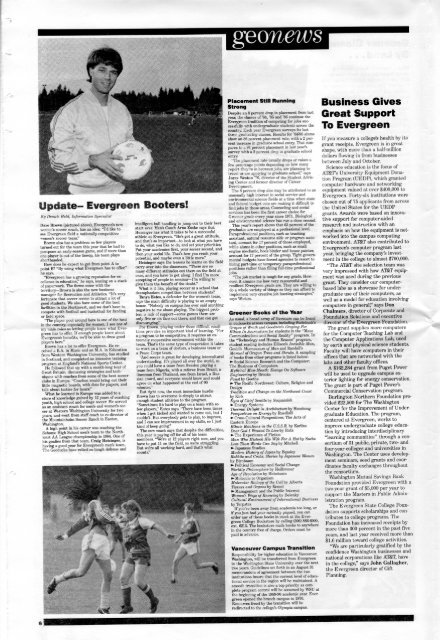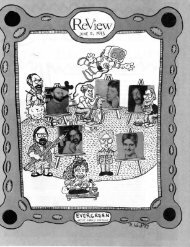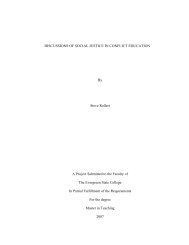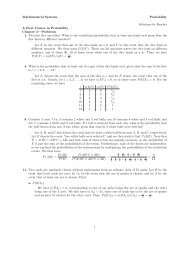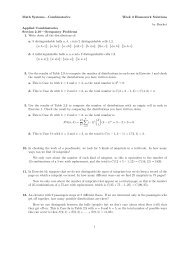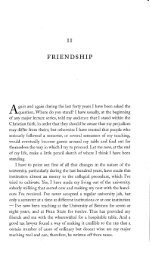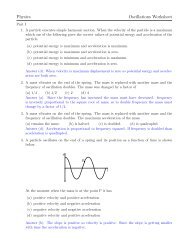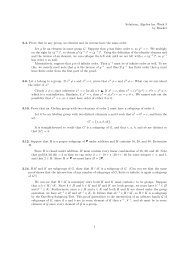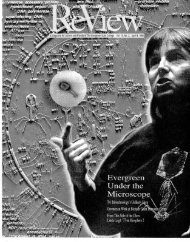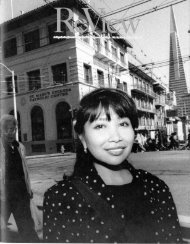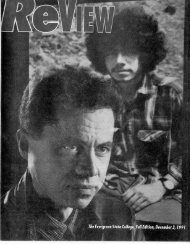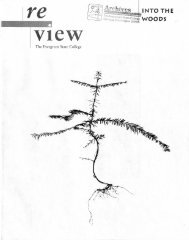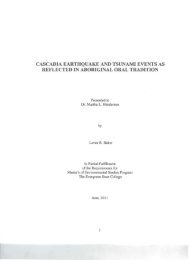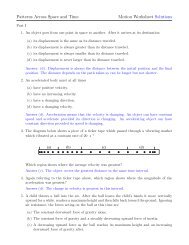V9 #1 November 1987 - Archives - The Evergreen State College
V9 #1 November 1987 - Archives - The Evergreen State College
V9 #1 November 1987 - Archives - The Evergreen State College
You also want an ePaper? Increase the reach of your titles
YUMPU automatically turns print PDFs into web optimized ePapers that Google loves.
Update- <strong>Evergreen</strong> Booters!<br />
By Dennis Held, Information Specialist<br />
Dave Brown (pictured above), <strong>Evergreen</strong>'s new<br />
women's soccer coach, has an idea: "I'd like to<br />
see <strong>Evergreen</strong> field a nationally-competitive<br />
women's soccer team."<br />
Brown alse has a problem: so few players<br />
turned out for the team this year that he had to<br />
postpone an early-season game, and if more than<br />
one player is out of the lineup, his team plays<br />
shorthanded.<br />
How does he expect to get from point A to<br />
point B? "By using what <strong>Evergreen</strong> has to offer"<br />
he says.<br />
"<strong>Evergreen</strong> has a growing reputation for excellence<br />
in education," he says, leaning on a stack<br />
of paperwork. <strong>The</strong> forms come with the<br />
territory—Brown is also the new business<br />
manager for Recreation and Athletics. "It's very<br />
fortunate that soccer seems to attract a lot of<br />
good students. We also have some of the best<br />
facilities in the Northwest, and we don't have to<br />
compete with football and basketball for funding<br />
or field space.<br />
"<strong>The</strong> player pool around here is one of the best<br />
in the country, especially for women. I see one of<br />
my main roles as letting people know what <strong>Evergreen</strong><br />
has to offer. If enough people know about<br />
<strong>Evergreen</strong>'s benefits, we'll be able to draw good<br />
players here."<br />
Brown has a lot to offer <strong>Evergreen</strong>. He received<br />
a B.A. in Music and an M.A. in Education<br />
from Western Washington University, has studied<br />
in Scotland, and completed an intensive training<br />
program at England's National Sports Center.<br />
He followed that up with a month-long tour of<br />
Great Britain, discussing strategies and techniques<br />
with coaches from some of the best soccer<br />
clubs in Europe. "Coaches would bring out their<br />
little magnetic boards, with dots for players, and<br />
talk about tactics for hours."<br />
What he learned in Europe was added to a<br />
store of knowledge gained by 12 years of coaching<br />
youth, high school and college soccer. He served<br />
as an assistant coach for men's and women's soccer<br />
at Western Washington University for two<br />
years, and went from staff coach to co-director of<br />
the Mountainholm Soccer Ranch in Easton,<br />
Washington.<br />
A high point in his career was coaching the<br />
Sehome High School men's team to the Northwest<br />
AA League championship in 1984. One of<br />
his goalies from that team, Craig Heisinger, is<br />
having a good year for <strong>Evergreen</strong>'s men's team.<br />
<strong>The</strong> Geoducks have relied on tough defense and<br />
intelligent ball handling to jump out to their best<br />
start ever. Men's Coach Arno Zoske says that<br />
Heisinger has what it takes to be a successful<br />
athlete at <strong>Evergreen</strong>. "He's got a great attitude,<br />
and that's so important—to look at what you have<br />
to do, what you like to do, and set your priorities.<br />
Put your academics first, your soccer second, and<br />
then your social life. That's how you reach your<br />
potential, and maybe even a little more."<br />
Heisinger says the lessons he learns on the field<br />
carry over into the classroom. "<strong>The</strong>re are so<br />
many different attitudes out there on the field at<br />
once, and you have to get along. I find I'm more<br />
accepting of people in seminar—I'm willing to<br />
give them the benefit of the doubt."<br />
What is it like, playing soccer at a school that<br />
deemphasizes competition between students?<br />
Tiinya Estes, a defender for the women's team,<br />
says the main difficulty is playing to an empty<br />
house. "Nobody on campus has ever said anything<br />
negative to me about playing. <strong>The</strong> biggest problem<br />
is lack of support—some games there are<br />
only five or six fans out there, and that can get<br />
discouraging."<br />
For Brown, playing under those difficult conditions<br />
provides an important kind of learning. "For<br />
a program to be competitive, it requires an extremely<br />
cooperative environment within the<br />
team. That's the same type of cooperation it takes<br />
to work on a team of doctors, a business team or<br />
a Peace Corps team.<br />
"And soccer is great for developing intercultural<br />
understanding. It's played all over the world, so<br />
you could have a team from Sweden playing a<br />
team from Nigeria, with a referee from Brazil, a<br />
linesman from Thailand, one from Israel, a Russian<br />
crowd, and everyone would know and could<br />
agree on what happened at the end of 90<br />
minutes."<br />
But right now, the most immediate hurdle<br />
Brown has to overcome is simply to attract<br />
enough student athletes to the program.<br />
"Sometimes it's hard to play on a team with so<br />
few players," Estes says. "<strong>The</strong>re have been times<br />
when I got kicked and wanted to come out, but I<br />
couldn't. But everybody gets to play, to improve,<br />
and I can see improvement in my skills, so I just<br />
kind of keep going."<br />
<strong>The</strong> new coach says that despite the difficulties,<br />
this year is paying off for all of his team<br />
members. "We're at 12 players right now, and you<br />
have to put 11 on the field, so we're struggling.<br />
But we're all working hard, and that's what<br />
counts."<br />
geonews<br />
Placement Still Running<br />
Strong<br />
Despite an 8 percent drop in placement from last<br />
year, the classes of '84, '85 and '86 continue the<br />
<strong>Evergreen</strong> tradition of competing for jobs successfully<br />
with undergraduate students across the<br />
country. Each year <strong>Evergreen</strong> surveys its last<br />
three graduating classes. Results for '84:86 alums<br />
show an 86 percent placement rate, with a 2 percent<br />
increase in graduate school entry. That compares<br />
to a 94 percent placement in last year's<br />
survey with a 2 percent drop in graduate school<br />
entry.<br />
"<strong>The</strong> placement rate usually drops or raises a<br />
few pecentage points depending on how many<br />
report they're in between jobs, are planning to<br />
travel or are applying to graduate school," says<br />
Joyce Weston '76, director of the Student Advising<br />
Center and former director of Career<br />
Development.<br />
<strong>The</strong> 8 percent drop also may be attributed to an<br />
unusually high interest in social service and<br />
environmental science fields at a time when state<br />
and federal budget cuts are making it difficult to<br />
find jobs in those areas. Counseling and social<br />
services has been the first career choice for<br />
Greener grads every year since 1971. Biological<br />
and environmental science has run a close second.<br />
This year's report shows that 63 percent of the<br />
graduates are employed at a professional level.<br />
Paraprofessional positions, such as teaching<br />
assistant, natural resource aide or program assistant,<br />
account for 17 percent of those employed,<br />
while alums in other positions, such as small<br />
engine mechanic, book binder and house painter,<br />
account for 17 percent of the group. Tight governmental<br />
budgets have forced agencies to resort to<br />
hiring part-time or temporary paraprofessional<br />
positions rather than filling full-time professional<br />
jobs.<br />
"<strong>The</strong> job market is tough for any grads. However,<br />
it amazes me how very resourceful and<br />
resilient <strong>Evergreen</strong> grads are. <strong>The</strong>y are willing to<br />
do a whole variety of things so they can afford to<br />
implement very creative job hunting strategies,"<br />
says Weston.<br />
Greener Books of the Year<br />
As usual, a broad array of literature can be found<br />
in rucksacks across campus, including Steinbeck's<br />
Grapes of Wrath and Goodwin's Groping For<br />
Ethics In Journalism for students in the "Mass<br />
Communications and Social Reality" program. In<br />
the "Technology and Human Reason" program,<br />
student reading includes Ellison's Invisible Man,<br />
Gould's Mismeasure of Man and Randall's<br />
Manual of Oregon Trees and Shrubs. A sampling<br />
of books from other programs is listed below:<br />
^- Social Science Research and the Computer:<br />
<strong>The</strong> Business of Computers<br />
Mythical Man-Month: Essays On Software<br />
Engineering by Brooks<br />
Faust by Goethe<br />
*• <strong>The</strong> Pacific Northwest: Culture, Religion and<br />
Design<br />
Tradition and Change on the Northwest Coast<br />
by Kirk<br />
Eyes of Chief Seattle by Suquamish<br />
*• Energy Systems<br />
<strong>The</strong>rmal Delight in Architecture by Heschong<br />
Perspectives on Energy by Ruedisili<br />
»• Cross-Cultural Perspectives: <strong>The</strong> Arts of<br />
Eastern Europe<br />
Ethnic Relations in the U.S.S.R. by Karlins<br />
Dear God I Wanted To Live by Ruta<br />
*• <strong>The</strong> Experience of Fiction<br />
Man Who Mistook His Wife For A Hatby Sachs<br />
Less Than Words Can Say by Mitchell<br />
*• Japanese Studies<br />
Modern History ofJapanby Beasley<br />
Rabbits and Crabs: Stories by Japanese Women<br />
by Birnbaum<br />
*• Political Economy and Social Change<br />
Worldly Philosophers by Heilbroner<br />
Age of Revolution\sy Hobsbawn<br />
*• Molecule to Organism<br />
Molecular Biology of the Cell by Alberts<br />
Tissues and Organs by Kessel<br />
>• Management and the Public Interest<br />
Women's Ways of Knowing'by Belenky<br />
Cultural Environment of International Business<br />
by Terpstra<br />
If you've been away from academia too long, or<br />
if you just had your curiosity piqued, you can<br />
order any of these books in stock at the <strong>Evergreen</strong><br />
<strong>College</strong> Bookstore by calling (206) 866-6000,<br />
ext. 6213. <strong>The</strong> bookstore mails books to anywhere<br />
in the country free of charge. Orders must be<br />
paid in advance.<br />
Vancouver Campus Transition<br />
Responsibility for higher education in Vancouver,<br />
Washington, will be transferred from <strong>Evergreen</strong><br />
to the Washington <strong>State</strong> University over the next<br />
two years. Guidelines set forth in an August 31<br />
memorandum of agreement between the two<br />
institutions insure that the current level of educational<br />
service in the region will be maintained. A<br />
smooth transition is also a top priority as complete<br />
program control will be assumed by WSU at<br />
the beginning of the 1989-90 academic year. <strong>Evergreen</strong><br />
opened the branch campus in 1976.<br />
Resources freed by the transition will be<br />
redirected to the college's Olympia campua<br />
Business Gives<br />
Great Support<br />
To <strong>Evergreen</strong><br />
If you measure a college's health by its<br />
grant receipts, <strong>Evergreen</strong> is in great<br />
shape, with more than a half-million<br />
dollars flowing in from businesses<br />
between July and October.<br />
Science education is the focus of<br />
AT&T's University Equipment Donation<br />
Program (UEDP), which granted<br />
computer hardware and networking<br />
equipment valued at over $400,000 to<br />
<strong>Evergreen</strong>. Forty-six institutions were<br />
chosen out of 75 applicants from across<br />
the United <strong>State</strong>s for the UEDP<br />
grants. Awards were based on innovative<br />
support for computer-aided<br />
research and instruction with an<br />
emphasis on how the equipment is networked<br />
into the campus computing<br />
environment. AT&T also contributed to<br />
<strong>Evergreen</strong>'s computer program last<br />
year, bringing the company's investment<br />
in the college to almost $700,000.<br />
"<strong>The</strong> AT&T site selection team was<br />
very impressed with how AT&T equipment<br />
was used during the previous<br />
grant. <strong>The</strong>y consider our computerbased<br />
labs as a showcase for undergraduate<br />
use of their computers, as<br />
well as a model for education involving<br />
computers in general," says Don<br />
Chalmers, director of Corporate and<br />
Foundation Relations and executive<br />
director of the <strong>Evergreen</strong> Foundation.<br />
<strong>The</strong> grant supplies more computers<br />
for the Computer Teaching Lab and<br />
the Computer Applications Lab, used<br />
by earth and physical science students.<br />
Faculty will have computers in their<br />
offices that are networked with the<br />
labs and other faculty offices.<br />
A $162,284 grant from Puget Power<br />
will be used to upgrade campus exterior<br />
lighting for energy conservation.<br />
<strong>The</strong> grant is part of Puget Power's<br />
Commercial Conservation program.<br />
Burlington Northern Foundation provided<br />
$22,500 for <strong>The</strong> Washington<br />
Center for the Improvement of Undergraduate<br />
Education. <strong>The</strong> program,<br />
centered at <strong>Evergreen</strong>, works to<br />
improve undergraduate college education<br />
by introducing interdisciplinary<br />
"learning communities" through a consortium<br />
of 31 public, private, two- and<br />
four-year colleges and universities in<br />
Washington. <strong>The</strong> Center uses development<br />
seminars, seed grants and coordinates<br />
faculty exchanges throughout<br />
the consortium.<br />
Washington Mutual Savings Bank<br />
Foundation provided <strong>Evergreen</strong> with a<br />
two-year grant of $5,000 per year to<br />
support the Masters in Public Administration<br />
program.<br />
<strong>The</strong> <strong>Evergreen</strong> <strong>State</strong> <strong>College</strong> Foundation<br />
supports scholarships and contributes<br />
to college programs. <strong>The</strong><br />
Foundation has increased receipts by<br />
more than 300 percent in the past five<br />
years, and last year received more than<br />
$1.6 million toward college activities.<br />
"We are particularly gratified by the<br />
confidence Washington businesses and<br />
national corporations like AT&T, have<br />
in the college," says John Gallagher,<br />
the <strong>Evergreen</strong> director of Gift<br />
Planning.


